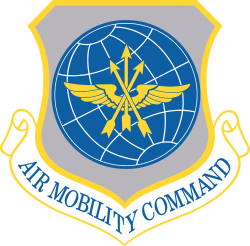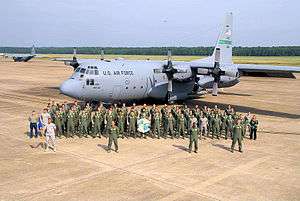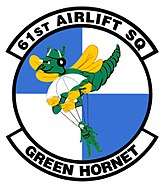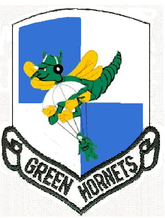61st Airlift Squadron
61st Airlift Squadron
 | |
|---|---|
 61st Airlift Squadron C-130 and personnel | |
| Active | 1942–1946; 1949–present |
| Country |
|
| Branch |
|
| Role | Airlift |
| Part of | Air Mobility Command |
| Garrison/HQ | Little Rock Air Force Base |
| Nickname(s) | Green Hornets |
| Engagements |
Mediterranean Theater of Operations Korean War Vietnam War Operation Just Cause[1] |
| Decorations |
Distinguished Unit Citation Air Force Outstanding Unit Award with Combat "V" Device Air Force Outstanding Unit Award Republic of Korea Presidential Unit Citation Republic of Vietnam Gallantry Cross with Palm[1] |
| Insignia | |
| 61st Airlift Squadron emblem (modified 3 March 1997)[1] |
 |
| 61st Troop Carrier Squadron emblem (approved 13 June 1956)[2] |
 |
The 61st Airlift squadron is part of the 19th Operations Group and operates Lockheed C-130 Hercules aircraft from Little Rock Air Force Base, Arkansas. The unit predominantly deploys in support of Operation New Dawn and Operation Enduring Freedom.
History
World War II
Activated in late 1942 under I Troop Carrier Command and equipped with Douglas C-47 Skytrains. Trained in various parts of the eastern United States until the end of 1943. Deployed to French Morocco in May 1943 and assigned to Twelfth Air Force to support combat operations in the North African Campaign. Remained with Twelfth Air Force, moving to Tunisia and Sicily providing transport and resupply operations as well as casualty evacuation of wounded personnel in the Mediterranean Theater of Operations. Reassigned to IX Troop Carrier Command in England during early 1944 as part of the build-up of Allied forces prior to the D-Day invasion of France.
Began operations by dropping paratroops into Normandy on D-Day (6 June 1944) and releasing gliders with reinforcements on the following day. The unit received a Distinguished Unit Citation and a French citation for these missions.
After the Normandy invasion the squadron ferried supplies in the United Kingdom. The squadron also hauled food, clothing, medicine, gasoline, ordnance equipment, and other supplies to the front lines and evacuated patients to rear zone hospitals. It dropped paratroops near Nijmegen and towed gliders carrying reinforcements during the Operation Market Garden, the airborne attack on the Netherlands. In December, it participated in the Battle of the Bulge by releasing gliders with supplies for the 101st Airborne Division near Bastogne.
Moved to Belgium in early 1945, and participated in the Western Allied invasion of Germany, participating in the air assault across the Rhine River in March 1945, each aircraft towed two gliders with troops of the 17th Airborne Division and released them near Wesel.
After V-E Day, became part of the United States Air Forces in Europe, moving to AAF Station Frankfurt and was part of the USAFE European Air Transport System, supporting the occupation forces in Germany as well as carrying supplies and personnel between various stations in Western Europe. Inactivated on 30 September 1946 in Germany.
Korean War
During the Korean War (1950-1953) furnished airlift between Japan and rough airfields in Korea and airdropped paratroops and supplies at Sukchon/Sunchon and Munsan-ni during combat operations.
Tactical Air Command
Remained in Japan until 1954, then became a Tactical Air Command Troop Carrier squadron, assigned to Sewart Air Force Base, Tennessee under Eighteenth Air Force. Supported Air Force and Army units in the United States with tactical airlift and troop carrier operations, including support for army airborne units at Fort Bragg, North Carolina (82d Airborne) and Fort Campbell, Kentucky (101st Airborne) as required. The 61st also had the first C-130D, the "ski model" and flew in support of the Distant Early Warning Line sites in Greenland during the late 50s and early 60s.
Vietnam War
During the Vietnam War, the squadron transported supplies from the Philippines into Southeast Asia, Dec 1965-Jun 1966. Part of squadron deployed to South Vietnam in the summer of 1972 to test the Adverse Weather Aerial Delivery System (AWADS) in combat for the first time. In 1972, operated from Taiwan and provided flood relief in the Philippines.
Deployments
After the end of the Vietnam War, engaged in routine theater airlift operations, both in the United States and in Europe, deploying frequently to RAF Mildenhall, England and Rhein-Main Air Base, West Germany to support USAFE and USAREUR Army units and combat exercises. Airdropped humanitarian relief supplies to Kurdish civilians in northern Iraq, Apr-May 1991 in the immediate aftermath of the 1991 Gulf War.
Air Mobility Command
Conducted airdrop and aeromedical evacuation; supported combatant commanders with theater delivery of personnel and supplies, 2000 – present
Campaigns and Decorations
- Campaigns: World War II: Sicily; Naples-Foggia; Rome-Arno; Normandy; Northern France; Rhineland; Central Europe. Korea: UN Defensive; UN Offensive; CCF Intervention; First UN Counteroffensive; CCF Spring Offensive; UN Summer-Fall Offensive; Second Korean Winter; Korean Summer-Fall, 1952; Third Korean Winter; Korea, Summer 1953. Vietnam: Vietnam Defensive; Vietnam Air. Armed Forces Expeditionary Streamers. Panama, 1989-1990.
- Decorations: Distinguished Unit Citations: Sicily, 11 July 1943; France, [6-7] Jun 1944; Korea, 28 November-10 Dec 1950. Air Force Outstanding Unit Awards: 6 May 1953 – 10 September 1954; 11 January-14 Feb 1955; 23 March-22 Aug 1959; 1 January 1960 – 31 December 1961; 1 September 1962 – 15 April 1963; 1 June 1969 – 31 May 1971; 1 January 1975 – 30 June 1976; 1 June 1985 – 31 May 1986; 1 July 1991 – 30 June 1993; 1 July 1993 – 30 June 1995; 1 July 1995 – 31 March 1997; 1 April 1997 – 30 June 1998; 1 July 2000 – 30 June 2001; 1 July 2001 – 30 June 2002. Republic of Korea Presidential Unit Citation: 1 July 1951 – 27 July 1953. Republic of Vietnam Gallantry Cross with Palm: 1 April 1966 – 7 July 1968. General Joseph Smith Trophy, 2015 Most Outstanding Airlift Squadron in Air Mobility Command.
Lineage
- Constituted as the 61st Troop Carrier Squadron on 13 October 1942
- Activated on 26 October 1942
- Inactivated on 30 September 1946
- Redesignated 61st Troop Carrier Squadron, Medium on 20 September 1949
- Activated on 17 October 1949
- Redesignated 61st Troop Carrier Squadron on 1 March 1966
- Redesignated 61st Tactical Airlift Squadron on 1 May 1967
- Redesignated 61st Airlift Squadron on 1 December 1991[1]
Assignments
|
|
Stations
|
|
Aircraft
- Douglas C-53 Skytrooper, 1942-1943
- Douglas C-47 Skytrain, 1943-1945
- Waco CG-4A, 1943-1945
- Piper L-4 Grasshopper, 1945
- Fairchild C-82 Packet, 1949-1950
- Fairchild C-119 Flying Boxcar, 1950-1957
- Lockheed C-130 Hercules, 1956–present
References
Notes
Bibliography
![]()
- Anderson, Capt. Barry (1985). Army Air Forces Stations: A Guide to the Stations Where U.S. Army Air Forces Personnel Served in the United Kingdom During World War II (PDF). Maxwell AFB, AL yes: Research Division, USAF Historical Research Center. Archived from the original (PDF) on 23 January 2016. Retrieved 28 June 2017.
- Johnson, 1st Lt. David C. (1988). U.S. Army Air Forces Continental Airfields (ETO) D-Day to V-E Day (PDF). Maxwell AFB, AL: Research Division, USAF Historical Research Center. Archived from the original (PDF) on 29 September 2015. Retrieved 26 June 2017.
- Maurer, Maurer, ed. (1983) [1961]. Air Force Combat Units of World War II (PDF) (reprint ed.). Washington, DC: Office of Air Force History. ISBN 0-912799-02-1. LCCN 61060979. Retrieved 17 December 2016.
- Maurer, Maurer, ed. (1982) [1969]. Combat Squadrons of the Air Force, World War II (PDF) (reprint ed.). Washington, DC: Office of Air Force History. ISBN 0-405-12194-6. LCCN 70605402. OCLC 72556. Retrieved 17 December 2016.
- Ravenstein, Charles A. (1984). Air Force Combat Wings, Lineage & Honors Histories 1947-1977 (PDF). Washington, DC: Office of Air Force History. ISBN 0-912799-12-9. Retrieved 17 December 2016.
External links
- Nicholson, Bob. "The Green Hornets: 61st TCS and ALS Squadron: History". 61tcs.org. Retrieved 5 October 2017.

.svg.png)